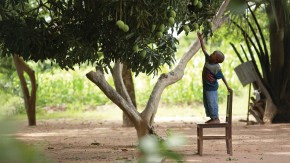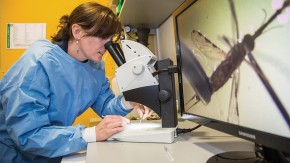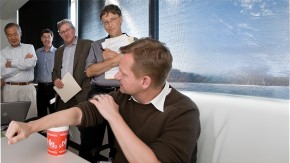Dry powder vaccines can be stored in a blister pack like this one, which protects them from contamination and makes them easier to transport and to use with the inhaler.
NEEDLE-FREE DELIVERY OF STABLE, RESPIRABLE POWDER VACCINE
- Jan 1, 2016
- Download Retrospective
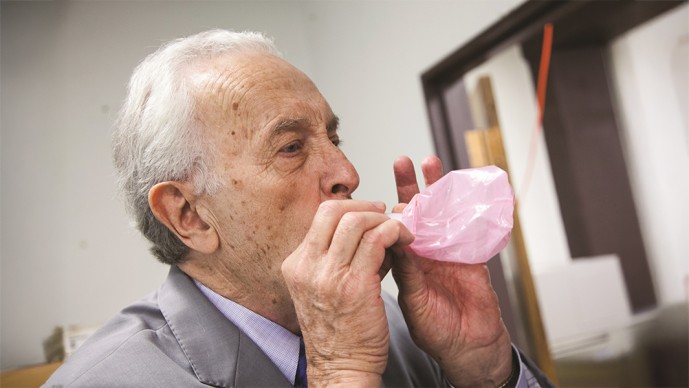
Bob Sievers demonstrates his needle-free inhaler for administering dry powder vaccines such as the one they made for measles.
Robert Sievers, Aktiv-Dry LLC, United States
In 2005, the Bill & Melinda Gates Foundation's new Grand Challenges in Global Health (GCGH) program awarded $51.1 million of the program's $450 million in research grants to target two formidable challenges: the redesign of existing childhood vaccines so that they can be administered without needles and syringes or so that they would no longer require refrigeration while being stored and distributed in remote communities. The GCGH program awarded grants to eight research groups under these two grand challenges - and to two additional groups targeting the challenge of creating effective single-dose vaccines that can be used shortly after birth - all with the goal of increasing immunizations for millions of children in the developing world's poorest regions.
At the time, public health organizations, including the Gates Foundation, believed that vaccines that could be delivered through the nose or mouth, or that retained potency in warm environments without refrigeration, would expand access to immunizations against preventable killers such as measles, pneumonia and virus-related diarrheal illnesses. The thinking was that the new formulations would be simpler to administer and deliver in hard-to-reach locales where trained health workers are scarce and cold-storage facilities requiring electricity are rare.
Ten years later, the inhalable vaccine against the measles virus developed by a research group led by Robert Sievers at the University of Colorado and at Aktiv-Dry LLC in Boulder, Colorado has shown evidence of being effective in tests in laboratory mice and primates, as well as being safe in a preliminary study in human volunteers. Sievers' product is a powdered version of the measles vaccine that is normally injected in liquid form. Inhaled as a puff of dried micro-particles, the powder becomes activated when it comes into contact with moist tissue lining the mouth and respiratory tract. Thus, it also doesn't need reconstituting in liquid like the existing measles vaccine, which then needs to be kept on ice and only remains fully active for a few hours. Sievers and his colleagues have done laboratory studies indicating that other vaccines that are injected in aqueous solutions also could be formulated and administered by the same inhaled dry powder technology.
Yet, Sievers' measles vaccine has been in limbo for three years. The Gates Foundation, which made the development of Sievers' inhalable-dry powder measles formulation possible with the largest of the grants for needle-free vaccine delivery - U.S. $20 million over five years from the GCGH program - has declined to further invest in it. The foundation has since then re-evaluated whether needle-free or so-called "thermostable" vaccines that remain effective without refrigeration will provide a substantial enough benefit to warrant additional research and development costs.
Without the additional funding, Serum Institute of India, a global vaccine maker that Sievers persuaded to join the project, isn't planning to support additional clinical trials - beyond those completed on adult volunteers - that are required to show the vaccine is safe and effective in children. Becton-Dickinson, a U.S. medical products maker, has terminated its work on one of the two inhaler devices developed to administer the vaccine.

"Bob has done everything right," says Steven Buchsbaum, head of the Gates Foundation's Grand Challenges programs. "When we started out, creating a needle-free, thermostable measles vaccine seemed like the right thing to do. But a bet we made in 2005, even though largely technically successful, doesn't necessarily imply that the larger investment required to take the product forward into clinical development makes sense now."
For Sievers, the stalled status is beyond frustrating. "We did everything required of us under the grant," says Sievers in a lengthy conversation in his office at the University of Colorado in Boulder where, for 40 years, he has been a professor of chemistry and biochemistry. "The last few years have been very difficult," he says. Tall, silver-haired and elegant, the 80-year old Sievers can make claim to numerous achievements as a well-respected teacher, university department chair, a dean, an inventor with 30 patents and an entrepreneur. In 1996, a laboratory instrument company that he had founded 12 years earlier sold for U.S. $21 million. In his spare time he carves large marble sculptures that have been exhibited throughout the U.S. West.
Yet, the inhaled dry powder measles vaccine may be his greatest accomplishment, at least for its potential impact. At one point during development of the needle-free technology he believed the inhaled vaccine could provide immunizations to 300 million children a year. "Our dream is a measles-free world," Sievers says. "We think our product can help make that happen".
Since 2001 international public health coalitions including the World Health Organization, UNICEF and funders such as the Gates Foundation have undertaken large-scale campaigns to dramatically expand distribution of childhood immunization against about 10 diseases that children in richer nations are routinely vaccinated against. As a result, deaths worldwide due to measles dropped 78 percent from 562,000 in 2000 to 122,000 in 2012, according to the WHO. As measles is still common in many developing countries, particularly in resource-poor parts of Africa and Asia, public health groups continue to explore strategies to address barriers to getting more children immunized. Needle-free, thermostable vaccines are still under consideration as one of a number of ways forward. But after years of debate there hasn't been a consensus that individual approaches, including Sievers' product, can improve access enough to justify the additional spending.
In 2003, when the GCGH grants were first announced, Sievers believed he and several colleagues already had invented a solution to reaching unvaccinated children. The path that brought him there started after the first lunar landings.
With an advanced degree in analytical chemistry, Sievers was recruited in the early 1970s to help analyze the composition of rocks and dust the Apollo astronauts brought back from the moon. Soon after that he was helping identify respiratory damage caused by inhaling airborne pollutants. In 1975, he was hired to restructure an analytical chemistry division at the University to further this kind of research.
By the late 1990s, Sievers was widely recognized for his expertise in aerosol chemistry, studying particles of metals and other materials so small they can spread in the air as near-invisible plumes of smoke or dust. Using this understanding, Sievers and several post-doctoral researchers working with him created a technique to produce ultra-thin layers of aerosolized metals to coat surfaces, a process that could be used in making tiny semiconductors that transmit electrical signals for computers. In 2002, he created a company, Aktiv-Dry LLC, to commercialize the process. Soon he was sought out by several pharmaceutical companies interested in using the approach to reformulate drugs for asthma or respiratory infections that could be inhaled, instead of injected, for quicker dispersal into the lungs and also to eliminate needles, making the products easier for at-home use.
The Puffhaler's projected cost including the dry powder measles vaccine of about 27 cents a dose, says Sievers, meets the GCGH grant's requirement that the per unit price be no more than the injectable vaccine.
He and his team named the process "carbon dioxide-assisted nebulization with a bubble dryer," or CAN-BD. It is the CAN-BD method that he has used to turn the injectable measles vaccine into an inhaled product. As currently constituted, the existing commercial measles vaccine is a version of the actual virus with certain components removed. This "inactivated virus" can spur a protective immune system response, but is too weak to cause an actual infection. In making the injectable vaccine, the inactive measles virus is mixed in an aqueous solution and then freeze-dried for shipping into small cake-like pellets. These pellets are then reconstituted back into a liquid form before injection.
"When I saw the [Grand Challenges in Global Health] grants seeking needle-free approaches I already knew CAN-BD could aerosolize therapeutics," says Sievers. "It was a matter of pulling together the right team to test and manufacture the product and also design an easy to use dispenser." The grant proposal came from Aktiv-Dry, which licenses the CAN-BD process. After reaching out without success to several vaccine makers, Sievers persuaded Serum Institute to provide vaccine samples, as well as to run clinical trials with the Gates funding. Sievers also brought in researchers from Johns Hopkins Medical School to conduct animal studies. After a breakfast with an acquaintance at Becton-Dickinson, Sievers convinced the medical products maker to further develop a low-cost, reusable inhaler using money from the Gates grant.
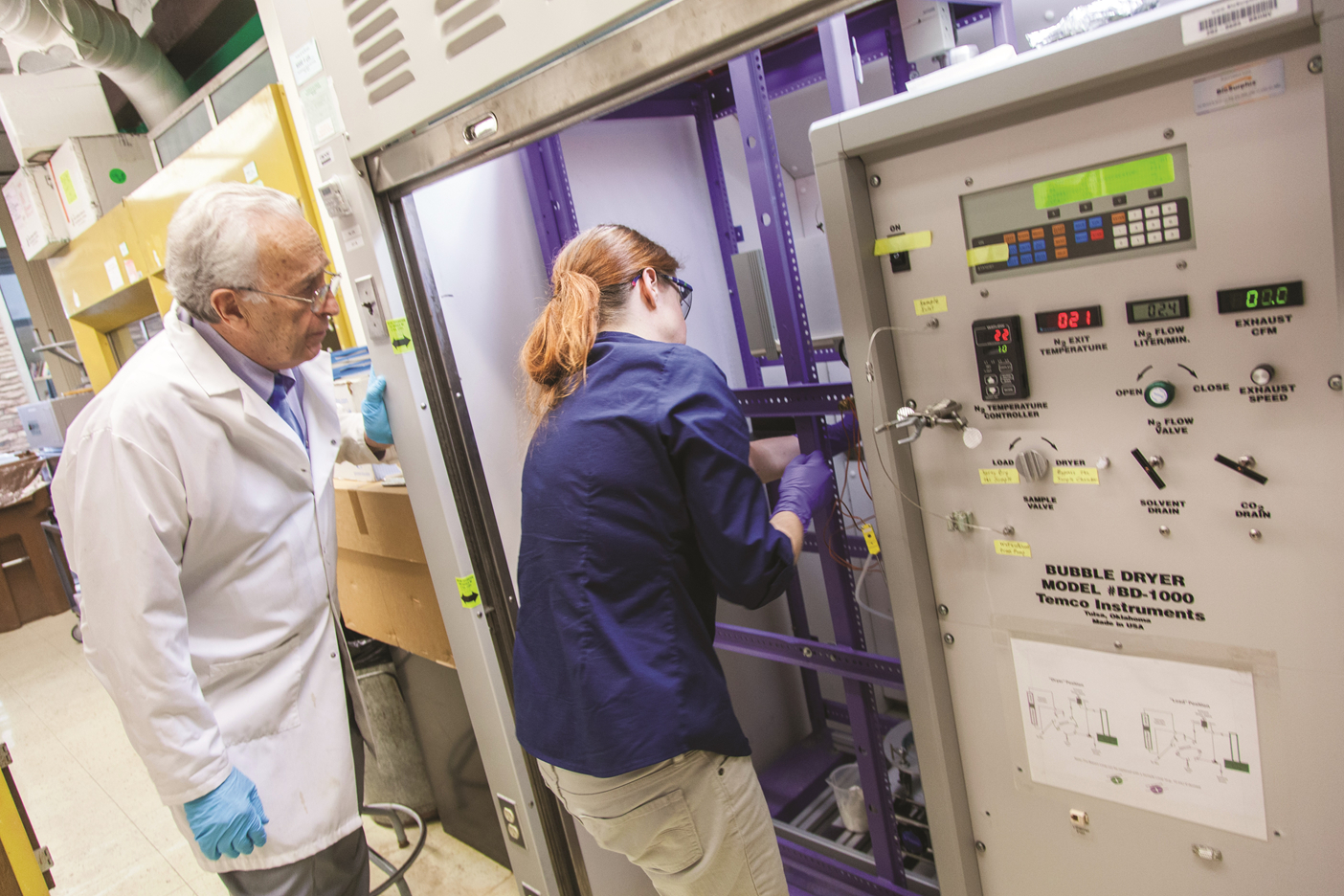
This bubble drier is used to make liquid vaccines into powder by drying micro sized vaccine particles.
The CAN-BD is a variation of industrial spray drying commonly used by food and pharmaceutical companies as a first step to creating a freeze-dried product. Sievers' invention is designed to create dried particles small enough to become aerosolized. Serum Institute provided Aktiv-Dry the vaccine in an aqueous suspension to which the Sievers team added sugars and other stabilizers. The CAN-BD device, about the size of a large consumer aerosol product, places this liquified mixture under highly concentrated carbon dioxide pressure, creating bubbles like those in carbonated soft drinks. The super-carbonated bubbles burst over and over until they are micro-sized droplets. These then are dried with nitrogen gas to form particles containing the weakened virus the size of a human red blood cell, or about one-tenth the thickness of a strand of human hair. By 2006, one year into the grant, the Sievers team showed that CAN-BD was able to turn the measles and hepatitis B vaccines, and several antibiotics, into micro-sized powder particles that retained their potency for 43 days at temperatures above 66 degrees Centigrade, and for four years at 2 to 8 degrees Centigrade.[1],[2]
The next step was to create an inhaler. In parallel to Becton-Dickinson, Sievers had members of his lab make their own device. "A good thing, too," Sievers says now, as Becton-Dickinson in late 2013 decided to shelve their inhaler after the Gates money dried up. Sievers' "Puffhaler" is composed of a rubber bulb connected to a plastic mask by a plastic tube following a pressure release valve. The powder is placed in a blister pack in the tube. Air created by squeezing the bulb passes through a valve that generates enough force to burst open the pressure release valve, sending the dispersed powder aerosol into the mask. The vaccine is administered by then taking the mask off the device, placing it over the mouth and nose and having the recipient breathe for about 30 seconds to consume the dose of vaccine. Adult patients inhaled the aerosol from a plastic bag in a clinical trial in volunteers.[3]

Bob Sievers and a colleague look over the CAN-BD process for making powder vaccines, which involves placing the liquid vaccine under highly concentrated carbon dioxide pressure to form bubbles that repeatedly burst and become smaller and smaller.
The Puffhaler's projected cost including the dry powder measles vaccine of about 27 cents a dose, says Sievers, meets the GCGH grant's requirement that the per unit price be no more than the injectable vaccine. The Puffhaler also would eliminate the likelihood of contamination that arises when syringe needles are repeatedly inserted and liquid is withdrawn from storage vials, he argues. In addition, use of inhaled dry powders might also avoid the loss of about 40 percent of the injectable products that are discarded when not enough children show up for vaccinations in the few hours the reconstituted vial liquids retain their potency. Sievers also points to a 2011 analysis backed by the Gates Foundation that showed that by eliminating this wastage, an inhalable dry powder could reduce the cost of a measles vaccine by 15 cents a dose, or hundreds of millions of dollars over 20 years.[4]
The study indicated that this benefit assumes the inhaled vaccine was proven at least as safe and effective as the existing vaccine. In a 2011 report conducted by Aktiv-Dry and the National Jewish Medical and Research Center in Denver, researchers showed in lab rats that the dry powder formulation readily entered the animals lungs and spurred an immune response comparable to the injectable vaccine.[5]
In a second study also published in 2011, researchers led by a team at Johns Hopkins found that the dry powder measles vaccine administered by the Puffhaler fully protected rhesus monkeys challenged with the measles virus.[6] But without additional support, Sievers can't fund clinical trials that he estimates would cost at least an additional $3 million over three years, with additional funds needed to take this all the way to commercialization.
A preliminary study of the inhaled vaccine conducted in 60 adult volunteers by a contract research organization in Pune, India found the inhaled version to be safe, says Sievers. But the results, published in 2014 in Vaccine,[3] were only analyzed by co-workers at the U.S. Centers for Disease Control late in 2013, three years after Aktiv-Dry first applied to Indian government regulatory authorities to carry out the test.
"Bob's done a remarkable job getting into the clinical phase," says Michael Gottlieb, deputy director of the GCGH initiative for the Foundation for the National Institutes of Health, which has managed 20 of the grants, including Sievers' project. "His personal persistence has been extraordinary."
Despite the success, Gottlieb told Sievers in late 2009 that the Gates foundation wasn't going to provide additional funding to support the trials for efficacy. "The foundation gave Bob some mixed messages after that suggesting he might get more money," says Gottlieb. "But now it looks like he's going to have to convince another partner to back the studies." So far, Serum Institute says it has no plans to support the studies.
Indeed, an internal analysis conducted by the Gates Foundation has determined that the initial investments in needle-free and thermostable vaccines didn't take into account whether, among other things, the pharmaceutical industry would be willing to invest their resources to test, manufacture and market the new formulation for the measles vaccine, or for other vaccines used in routine immunizations, given they already have vaccines on the market. In addition, the study concluded that immunization campaigns would still have to provide a so-called "cold chain" distribution system if only one or two vaccines were thermostable.[7]
Meanwhile, Sievers says he will continue to seek investors for the measles vaccine. Aktiv-Dry will also seek partners to use the CAN-BD technology. "We’ve created a platform that can have many uses beyond measles," says Sievers. "I'm not giving up."
THE SCIENCE:
Producing an active dry powder measles virus vaccine for aerosol delivery
Transforming liquid vaccines into dry powder formulations can improve stability and offers alternative methods of administration such as by inhalation, whereby moisture from the lungs allows rapid rehydration.[8] Carbon dioxide-assisted nebulization with a Bubble Dryer® (CAN-BD) is an elegant method developed by Sievers and colleagues that produces microparticles by combining pressurized CO2 with low temperatures without requiring an organic solvent. They applied it to myo-inositol-stabilized liquid Edmonston-Zagreb strain of the live attenuated measles vaccine (LAMV) and produced high viral titers in stable 3-5µm particles,[9] which is suitable for delivery to the lower airways. When tested in macaques, the inhaled vaccine protected them from challenge with the measles virus over one year later.[6]
The measles virus is highly infectious so over 95% of the population needs to be immune to block transmission.[10] LAMV currently requires two separate injections by trained health workers for full immunity. Thus, pulmonary delivery of a stable dry powder is a desirable alternative, and could be more effective as it mimics the natural infection route of the measles virus.[11] The route of infection dictates which cells mount the initial innate immune response, and how the subsequent adaptive response develops. A single dose of the dry powder measles vaccine entered and replicated in the lower respiratory tract in macaques and in cotton rats, with rapid production of measles virus-specific antibodies and T-cell responses comparable to the injected vaccine.[5],[6] The CAN-BD method could also be applied to other live attenuated virus vaccines for airborne diseases such as varicella, mumps and rubella.
REFERENCES:
[1] R.E. Sievers RE, Quinn BP, Cape SP, Searles JA, Braun CS, Bhagwat P, Rebits LG, McAdams DH, Burger JL, Best JA, Lindsay L, Hernandez MT, Kisich KO, lacovangelo T, Kristensen D, Chen D. Near-critical fluid micronization of stabilized vaccines, antibiotics and anti-virals. J Supercritical Fluids 42, 385 (2007).
[2] Cape SP, Villa JA, Huang ET, Yang TH, Carpenter JF, Sievers RE. Preparation of active proteins, vaccines and pharmaceuticals as fine powders using supercritical or near-critical fluids. Pharm Res. 25, 1967 (2008).
[3] [a],[b] MVDP author group, Cape S, Chaudhari A, Vaidya V, Mulay R, Agarkhedkar S, Shermer C, Collins M, Anderson R, Agarkhedkar S, Kulkarni PS, Winston S, Sievers R, Dhere RM, Gunale B, Powell K, Rota PA, Papania M. Safety and immunogenicity of dry powder measles vaccine administered by inhalation: a randomized controlled Phase I clinical trial. Vaccine 32, 6791 (2014).
[4] Garrison LP Jr, Bauch CT, Bresnahan BW, Hazlet TK, Kadiyala S, Veenstra DL. Using cost-effectiveness analysis to support research and development portfolio prioritization for product innovations in measles vaccination. J Infect Dis. 204, S124 (2011).
[5] [a],[b] Kisich KO, Higgins MP, Park I, Cape SP, Lindsay L, Bennett DJ, Winston S, Searles J, Sievers RE. Dry powder measles vaccine: particle deposition, virus replication, and immune response in cotton rats following inhalation. Vaccine 29, 905 (2011).
[6] [a],[b],[c] Lin WH, Griffin DE, Rota PA, Papania M, Cape SP, Bennett D, Quinn B, Sievers RE, Shermer C, Powell K, Adams RJ, Godin S, Winston S. Successful respiratory immunization with dry powder live-attenuated measles virus vaccine in rhesus macaques. Proc Natl Acad Sci U S A 108, 2987 (2011).
[7] Karp CL, Lans D, Esparza J, Edson EB, Owen KE, Wilson CB, Heaton PM, Levine OS, Rao R. Evaluating the value proposition for improving vaccine thermostability to increase vaccine impact in low and middle-income countries. Vaccine 33, 3471 (2015).
[8] Griffin DE. Current progress in pulmonary delivery of measles vaccine. Expert Rev Vaccines 13, 751 (2014).
[9] Burger JL, Cape SP, Braun CS, McAdams DH, Best JA, Bhagwat P, Pathak P, Rebits LG, Sievers RE. Stabilizing formulations for inhalable powders of live-attenuated measles virus vaccine. J Aerosol Med Pulm Drug Deliv. 21, 25 (2008).
[10] Gay NJ. The theory of measles elimination: implications for the design of elimination strategies. J Infect Dis. 189, S27 (2004).
[11]Sabin AB. Immunization against measles by aerosol. Rev Infect Dis. 5, 514 (1983).
